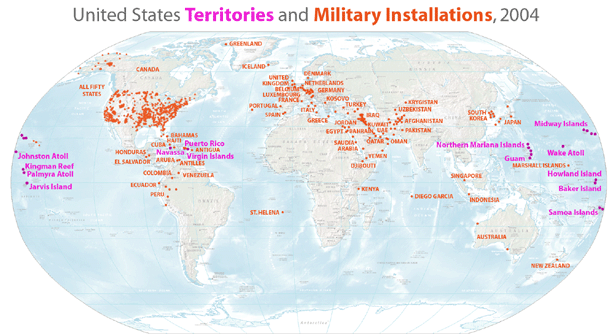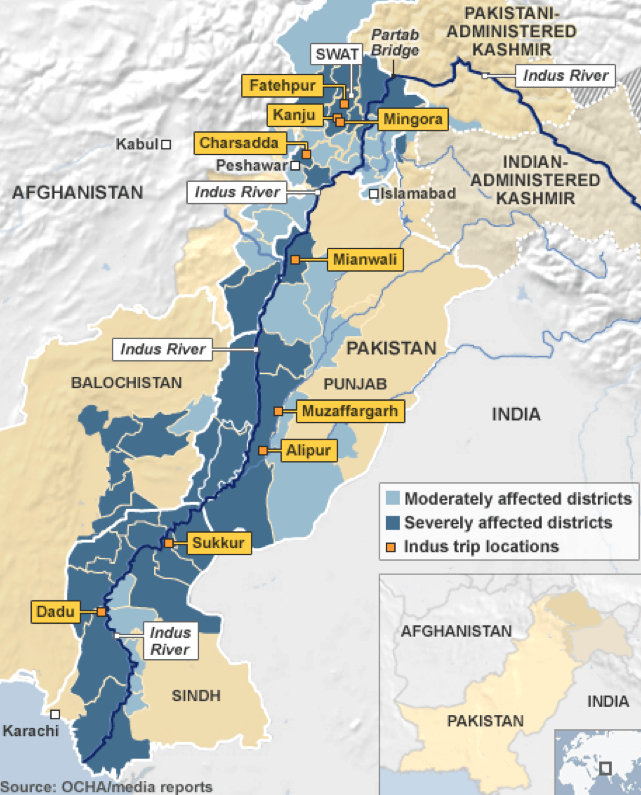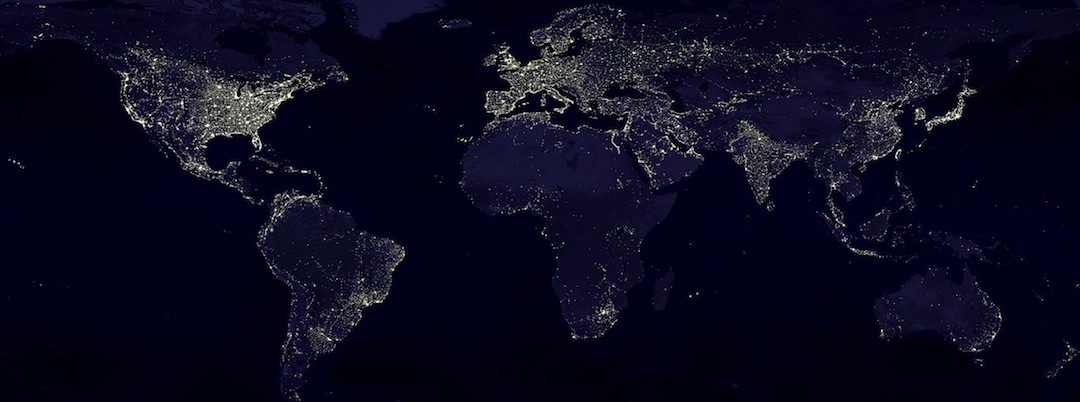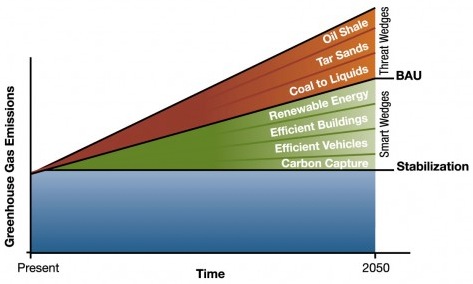The Challenges to National Security from Climate Change
"The Challenges to National Security from Climate Change"
By Joseph Vincent Siry, Ph.D., Faculty Rollins College
17th Annual Northeast Florida Environmental Summit; February 25, 2016. Jacksonville, Fa.
Premise
Global reach requires an equally expansive international imagination to deal with global warming effectively because ample means exist to cope now with abrupt climate change. 1
"our eyes have been opened by the steady increase in climate change impacts in every country and on every continent. It is clear that no one is immune from climate change. We are all in this together, sink or swim."
AOSIS Statement, December 12, 2015.
"DoD recognizes the reality of climate change and the significant risk it poses to U.S. interests globally.
The National Security Strategy, issued in February 2015, is clear that climate change is an urgent and growing threat to our national security, contributing to increased natural disasters, refugee flows, and conflicts over basic resources such as food and water."
National Security Implications . . . Department of Defense. July 23, 2015.
Places where the United States possesses an armed presence.
“The report concludes the Defense Department already is observing the impacts of climate change in shocks and stressors to vulnerable nations and communities, including in the United States, the Arctic, the Middle East, Africa, Asia and South America, officials said.”
DoD Releases Report on Security Implications of Climate Change [July 29, 2015], pp. 1 & 4.
The 2010 map of the extent of the Indus River's flooding."Massive flooding in Pakistan in 2010 was the country’s worst in recorded history, killing more than 2,000 people and affecting 18 million; DoD delivered humanitarian relief to otherwise inaccessible areas."
"NATIONAL SECURITY IMPLICATIONS OF CLIMATE-RELATED RISKS AND A CHANGING CLIMATE." (23 July 2015), p.4.
• More than 25 years after scientists raised the alarm, the problem of climate change remains largely unchecked.
• Challenging the validity of human induced abrupt climate change is a dangerous distraction.
• We have a limited duration to act within a closing window of opportunity to reduce pollution, assess the vulnerability of populations and property, and to adapt before enormous consequences of ocean and atmospheric instability overwhelm civic institutions.
• Ocean acidification from nitrogen and carbon oxides is now 30 percent higher than the 19th century and increasing at a pace faster than marine life –a viable source of protein food– can adapt.
Mitigation of existing pollution and adaptation to the consequences of carbon dioxide saturation are often misunderstood as commercially too costly. The use of geothermal, solar, and wind fuel sources are viable means to meet a wide range of social improvement objectives, instead of increasing consumptive use in light of declining certainties in water availability.
Their widespread use would mean mitigation of pollution from electricity needed for development and transportation. These three sources of energy may allow for the resiliency necessary for adequate hygiene, sufficient crops, and widespread electrification to foster effective adaptive strategies to unpredictable, future weather pattern, soil loss, and water shortages.
National Security & threats from Abrupt Climate Change
"These impacts are already occurring, and the scope, scale, and intensity of these impacts are projected to increase over time."
• "Fragile States Vulnerable to Disruption"
• "Integrating Climate-Related Impacts Into Planning"
National Security Implications . . .
Department of Defense. July 23, 2015.
Since the United States maintains over 725 bases in over sixty countries, the national commitment to defending against the consequences of global warming in terms of floods, droughts, aggravated food shortages, and over-extended supply lines has not been ignored by the Department of Defense or the CIA.
October 2014, the U.S. Department of Defense declared that climate change is an immediate threat to national security, citing increased risks from terrorism, infectious disease, global poverty and food shortages. The Department of Defense also predicted increasing demand for military responses to disasters as extreme weather creates more global humanitarian crises.
"October 13, 2014 — Defense Secretary Chuck Hagel will outline ... The U.S. defense strategy refers to climate change as a “threat multiplier,” stated in a "DOD report: 2014 Climate Change Adaptation Roadmap."
In a 20-page report released on Monday, the Pentagon details its strategic blueprint to address climate change, calling it a "threat multiplier" that has the power to "exacerbate" many of the challenges the U.S. faces today, including "infectious diseases and terrorism."
The Hill, staff - 10/13/14 01:54 PM EDT
Navigator
A • B • C • D • E • F
Scope of thinking
A. Accelerating: Climate change is accelerating to a threshold or point of no return – designated to be 2˚C
“Addressing climate change is urgent because of the calamitous consequences climate change can have if left unchecked: it could make some countries uninhabitable, cause costly damage to infrastructure, increase mortality and prevalence of disease, and make it more difficult to eradicate poverty. In fact, climate change is already taking a considerable toll in some places, and the costs will keep rising."
Stockholm Environment Institute, 2016.
B. Because "time is at a premium" due to the rate of increasing pollution.
Decadal Average rates of increase:
1.23 {1969-1978 average annual rate of increase of Carbon dioxide} 1.86 {1999-2008 average annual rate of increase of Carbon dioxide} 2.05 {2005-2014 average annual rate of increase of Carbon dioxide} Arctic thawing's consequences
- Weather patterns shifted with loss of sea ice.
- Opening of the Northwest passage: Canada, Russia, US, EU.
- thermohaline circulation; Gulfstream is slowing.
- loss of reflective snow cover is a positive feedback driver: oceans to absorb light.
- permafrost acts as a positive feedback in releasing methane–adding to heat trapping gas.
The pace of Himalayan glacial retreat
- Over one third of the world's population relies on rivers whose source are the ice.
- Variability and timing of the East Indian Monsoon.
- China, Kashmir, India, Pakistan, Bangladesh, Thailand, Laos, & Vietnam.
C. confluence of tipping points is troublesome.
Areas requiring reconsideration:
Refugees, there is a legal need to redefine the United Nations' status of people fleeing due to climate related conditions such as prolonged drought (Africa and Southwest Asia) or flood (Punjab along the India and Pakistan borderlands) among small island states and Pacific coastal regions (Palau & the Philippines).
“The mass migration of climate refugees …will mark the 21st century.”
Jean Jouzel, “Introduction,” Climate Refugees, p. 16.
Civil wars: Tunisia, Egypt, Libya, Darfur, Gulf States, Yemen, Syria, Iraq, Afghanistan. "the risk of instability and conflict overseas."
National Security Implications . . . p. 3.
2006-2011, a severe multi-year drought affected Syria 1 and contributed to massive agriculture failures and population displacements. Large movements of rural dwellers to city centers coincided with the presence of large numbers of Iraqi refugees in Syrian cities, effectively overwhelming institutional capacity to respond constructively to the changing service demands.
These kinds of impacts in regions around the world could necessitate greater DoD involvement in the provision of humanitarian assistance and other aid.
DoD; 2015, Page 4.
Failed states: Maldives, Ethiopia, Somalia, Sudan, Mauritania, Nigeria.
Food & nutrition: "The effect of our food system on climate change is something that is often overlooked." Food production and delivery is responsible for one-third of heat trapping gas emissions globally.
Dr. David Cleveland, U.C.S.B.
A • B • C • D • E • F • MAP
Are there any commonalities in all of these critical areas?
Composite satellite map of Earth at night depicting light as examples of electricity use among habitable regions.
A • B • C • D • E • F
D. This is the paramount solvable problem of our times.
Lessons we need to learn
Alliance of Small Island States. AOSIS; role in the United Nations.
" . . . history will judge us not by what we did today, but by what we do from this day forward. That is how the Paris agreement will be measured: by future generations."
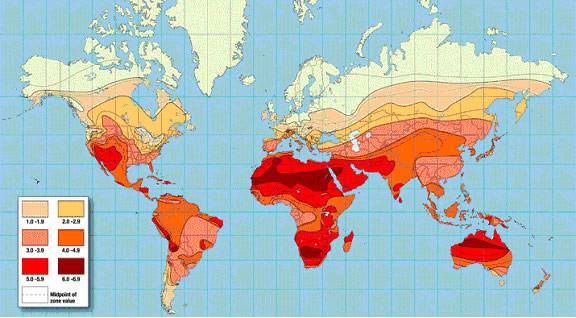
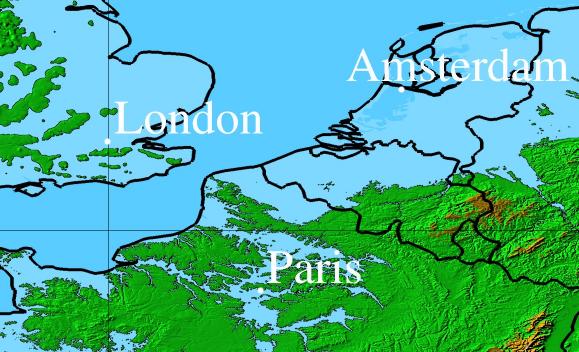
A map of solar exposure as one means to cut emissions exist worldwide; the threats to N.A.T.O. are real.
Africa, 1500 marines occupy a French Foreign legion post in Djibouti on the Gulf of Aden.
Asia, 37 bases remain on the Island of Okinawa, seventy years after Japan's surrender.
Americas, tropical diseases, "War on drugs," oil dependency versus geothermal energy frontier.
USA, a map of the affects of sea level changes on bases in Southeastern Virginia.
A • B • C • D • E • F
Existing solutions must become more widely used.
There are solutions that even the military are deploying that must become more widespread if the COP-21 promises are ever to materialize in a more moderate rise in planetary temperatures.
| Illustration | remedies | consequences |
|---|---|---|
| Comparison | 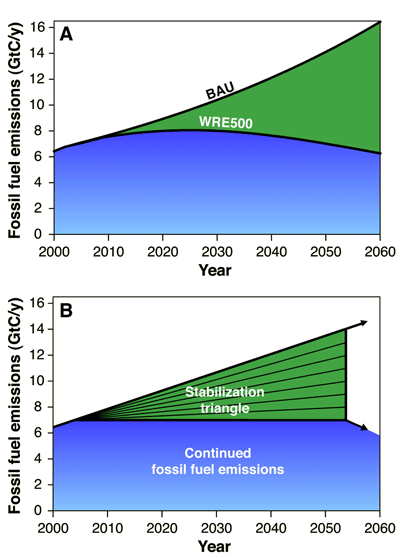 |
4˚ C |
| 3˚ C | ||
| 2˚ C | ||
| Steps | ||
| Wind | ||
| Solar | ||
| Geothermal | ||
| CS technology | ||
A similar lack of imagery blinds us from comprehending 15 effective strategies that can be more widely adopted to reduce our risks from global warming. The recent suggestions of Pacala and Sokolow, two Princeton scientists, assume that the country “already possesses the fundamental scientific, technical, and industrial know-how to solve the carbon and climate problem for the next half-century.”
√ They argue that each billion ton of reduction represents existing technology and how such things as wind energy or other non-carbon fuels lowers ever so slightly the increasing rate of heat trapping gases.
√ Each solution is represented as a slice on a graph representing such techniques as installing solar water heaters as is done throughout Israel to lower the demand for electricity.
Referred to as a dozen or more steps called “wedges” by climate change community insiders, their solutions are targeted at the root of the problem consuming too much energy inefficiently. Any solar water heater’s energy savings is represented as a thin wedge because thermal solar lowers the need for fossil fuel generated electricity. A solar energy policy reduces carbon emission ever so slightly as does an option to use wind power and thus the rate of accelerating heat trapping gas emission is reduced by another narrow sliver. Place enough of these fuel switching, conservation, or design changes together and each small step–a wedge–leads to a larger combined reduction in the rate of increase.
BAU means business as usual; or the continued use of coal, oil and natural gas fuels at current rates of consumption with some efficiency improvements & consumer responses to costlier fuel sources.
A • B • C • D • E • F
Tomorrow's Climate is Today's Challenge
"life boat Britain"
"The increasingly routine tidal flooding is making life miserable in places like Miami Beach; Charleston, S.C.; and Norfolk, Va., even on sunny days."
Justin Gillis, "Seas Are Rising at Fastest Rate in Last 28 Centuries," New York Times, February 22, 2016.
'Day after tomorrow' map shows consequences of climate change
Britain faces rising sea levels, floods and drought unless more is done to stop global warming, according to a new map produced by the Government.
The Telegraph (UK)
By Louise Gray, Environment Correspondent7:39PM BST 22 October 2009"'Prove it – everything you need to know to believe in climate change' is aimed at educating the public about the dangers of uncontrollable global warming."
for Map see: http://i.telegraph.co.uk/multimedia/archive/01508/Climate-ChangeNEW_1508747a.jpg
A • B • C • D • E • F
The take-away
Time is at a premium.
There is an immediate need to more widely use existing solutions to prevent, adapt to, and mitigate the human sources of abrupt climate change due to human pollution.
Ocean warming, acidification, and the life-time of atmospheric carbon will persist for generations.
There is something you can do to reduce the risks to property, livelihoods, and lives if we act soon.
If you do not act, the armed forces will act, because resilience in regard international security is effectively promoted by geothermal, solar, and wind power sources to defend your freedoms.
notes
DOD procurements.
√ The U.S. Department of Defense (DOD) is the nation's largest energy user (and buyer of petroleum).
√ Many fuels require water in some form to refine, or transform into electricity.
√ U.S. Navy committed last year to solar electricity on Pacific bases.
√ Could / should geothermal energy be a means of base maintenance?
A • B • C • D • E • F
Sources
National Security Implications of Climate-Related Risks and a Changing Climate; U.S. Department of Defense: DoD, July 23, 2015. Submitted in response to a request contained in Senate Report 113-211, accompanying H.R. 4870, the Department of Defense Appropriations Bill, 2015.
The Climate Web: "Climate Web™ represents the first time that information from disciplines as wide-ranging as climate science, risk and risk management, climate impact forecasting, business decision-making, technology innovation, and communications has been linked together to facilitate climate change learning, constructive discussion, and improved decision-making." Climate cartography is used to guide users through the enormous amount of data.
Climate Central: "Climate Central bridges the scientific community and the public, providing clear information to help people make sound decisions about the climate."
American University's International Service Schools "Global Environmental Policy" website.
Gwynne Dyer, Climate Wars: The Fight for Survival as the World Overheats. 2010
Dr. Gwen Dyer, Ph.D. military history; CBC journalist; Gwynne Dyer – Geopolitics in a Hotter World.
Link see One-World; ISBN: 9781851688142
Book Review of Climate Wars (August 2010).
Interpreting new maps from UK's MET office: RISK AND ADAPTATION | July 18. 2014. 0:00
Outline
- Premise
- National Security & threats from Climate Change
- Scope of thinking
- Consideration of this evidence
- The four reconsideration points:
- refugees: Pakistan, Micronesia, Bangladesh.
- civil wars: Syria, Darfur, Libya.
- failed states: Somalia, Iraq, Sudan, Nigeria.
- food security; Tunisia, Egypt, Lebanon, Malawi.
- Commonalities: water and energy are coupled
- The lessons
- Existing solutions as wedges
- DoD's role
- Closing points
- Sources & notes
Notes
Peter Gleick, “Water, Drought, Climate Change, and Conflict in Syria,” Pacific Institute, February 2, 2014. American Meteorological Society.
Stephen Pacala and Robert Socolow, "Stabilization wedges: solving the climate problem for the next 50 years with current technologies," Science 305 (2004), 968-972.
National Oceanic and Atmospheric Administration (NOAA) maps of coastal impacts from rising sea levels.
Issie Lapowskey. "How Climate Change Became a National Security Problem." WIRED Magazine, published 10.20.15 @ 7:00 AM.
" In other words, when you frame climate change as a security threat, the military will want to respond. . . . “People who are proponents of using the security framework to attract attention to this issue might not anticipate that when the military takes something seriously as a security threat, it has certain implications for the military,” Busby says."
3. Sea levels; rate of change:
Justin Gillis, "Seas Are Rising at Fastest Rate in Last 28 Centuries," New York Times, Feb 22, 2016.
Climate and National Security Exploring The Security Risks of Climate Change. The Center for Climate and Security (CCS), a non-partisan security and foreign policy institute with a distinguished Advisory Board of military, security and foreign policy experts, envisions a climate-resilient international security landscape. This is a world which recognizes that climate change threats to international security are significant and unprecedented, and acts to address those threats in a manner that is commensurate to their scale and probability.
Barber, Barrie. "Report: Climate change poses national security threat," Stars & Stripes, from Dayton Daily News, Ohio: May 14, 2014. "A graphic included with the report shows the potential impact of a rise in sea level on military facilities in the Hampton Roads, Va. area."
This article cites: Center for Naval Analyses report, entitled “National Security and the Accelerating Risks of Climate Change,” 2014.
"Former Air Force Materiel Command leader and retired Gen. Donald J. Hoffman was among those who signed the document and is a member of the federally funded research and development center’s military advisory board.
“The call to action I think is more urgent.” Hoffman said in an interview with the Dayton Daily News. “This is not something that we can just ignore.”
The longer action is delayed, the more challenging it will be to mitigate or adapt to climate change, the retired general said. “There’s enough evidence out there to say climate change is happening.”
"The CNA report said efforts to mitigate climate change thus far have not been enough to confront a future with the “significant potential” of water, food and energy insecurity, political instability, and extreme weather events, among other consequences.
“When it comes to thinking about the impacts of climate change, we must guard against a failure of imagination,”
Joshua Busby, "Climate Change and National Security," Council on Foreign Relations
"Climate change presents a serious threat to the security and prosperity of the United States and other countries.
Recent actions and statements by members of Congress, members of the UN Security Council, and retired U.S. military officers have drawn attention to the consequences of climate change, including the destabilizing effects of storms, droughts, and floods."
Center for Climate and Energy Solutions
Climate and National Security Watchdog Group
7. National Security matters – earliest data
An Abrupt Climate Change Scenario and Its Implications for United States National Security, October 2003 By
Peter Schwartz and Doug Randall
Imagining the Unthinkable
The purpose of this report is to imagine the unthinkable – to push the boundaries of current research on climate change so we may better understand the potential implications on United States national security. We have interviewed leading climate change scientists, conducted additional research, and reviewed several iterations of the scenario with these experts. The scientists support this project, but caution that the scenario depicted is extreme in two fundamental ways.
First, they suggest the occurrences we outline would most likely happen in a few regions, rather than on globally.
Second, they say the magnitude of the event may be considerably smaller. We have created a climate change scenario that although not the most likely, is plausible, and would challenge United States national security in ways that should be considered immediately.
Executive Summary
"There is substantial evidence to indicate that significant global warming will occur during the 21st Century."


